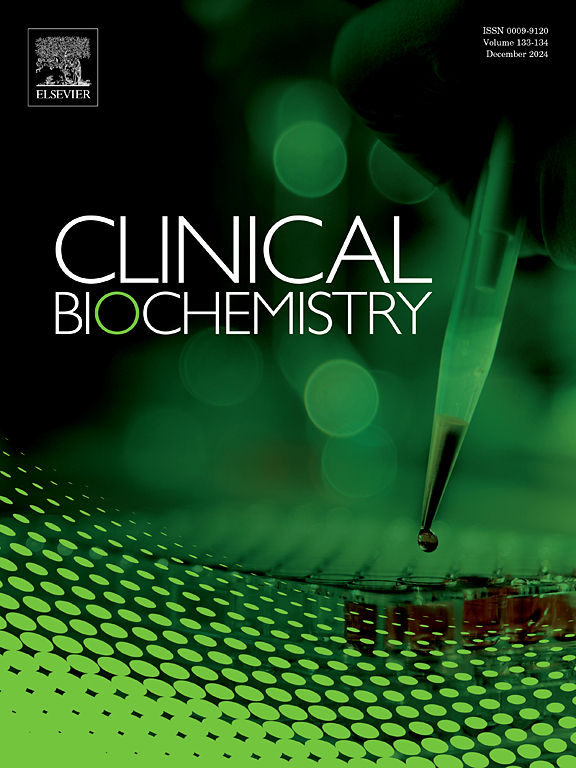糖尿病视网膜病变患者血清晚期糖基化终产物水平与对氧磷酶1和卵磷脂-胆固醇酰基转移酶活性呈负相关横断面病例对照研究。
IF 2.1
3区 医学
Q2 MEDICAL LABORATORY TECHNOLOGY
引用次数: 0
摘要
背景:糖尿病视网膜病变(DR)的发展与多种代谢途径引发的氧化应激密切相关。对氧磷酶1 (PON1)和卵磷脂-胆固醇酰基转移酶(LCAT)在DR中的保护作用尚不清楚。先前的研究表明,较高的AGEs水平及其在2型糖尿病血管并发症中的作用。本病例对照研究旨在评估伴有或不伴有视网膜病变的糖尿病患者的LCAT和PON1活性及其与晚期糖基化终产物(AGEs)的相关性。方法:选取45名健康人群和88名糖尿病患者,分为非糖尿病性视网膜病变(NDR)、非增生性糖尿病性视网膜病变(NPDR)和增生性糖尿病性视网膜病变(PDR)。结果:PON1和LCAT活性与糖尿病视网膜病变患者晚期糖基化终产物的血清水平呈负相关。没有DR的患者和对照组没有这样的相关性。PON1与AGEs的相关性较LCAT强。2型糖尿病患者PON1活性明显低于健康对照组(45.39 ± 16.48和203.75 ± 8.92,P 0.05)。结论:糖尿病患者血清PON1活性与AGEs水平呈负相关,而对照组无相关。然而,LCAT-AGEs相关性仅在PDR患者中具有显著性。这些发现强调了AGES和PON1在糖尿病视网膜病变发生和进展中的潜在重要性。本文章由计算机程序翻译,如有差异,请以英文原文为准。
Serum levels of advanced glycation end products negatively correlates with activity of Paraoxonase1 and Lecithin-Cholesterol Acyltransferase in diabetic retinopathy; A cross-sectional case-control study
Background
Development of diabetic retinopathy (DR) is closely linked to oxidative stress triggered by various metabolic pathways. Paraoxonase 1 (PON1) and Lecithin-Cholesterol Acyltransferase (LCAT) have protective roles in DR that remain poorly understood. Higher AGEs levels and its role in vascular complications of type 2 diabetes has been shown in previous studies. This case-control study aimed to assess LCAT and PON1 activity and their correlation with advanced glycation end products (AGEs) in patients with diabetes with or without retinopathy.
Method
45 healthy individuals and 88 diabetic patients were enrolled, categorized as No Diabetic Retinopathy (NDR), Non-Proliferative Diabetic Retinopathy (NPDR), and Proliferative Diabetic Retinopathy (PDR).
Results
PON1 and LCAT activity conversely correlated with serum levels of advanced glycation end products in patients with diabetic retinopathy. There was not such a correlation in patients without DR nor in controls. The correlation was stronger between PON1 and AGEs in comparison to LCAT.
PON1 activity was significantly lower in type 2 diabetes patients compared to healthy controls (45.39 ± 16.48 and 203.75 ± 8.92, respectively, P < 0.001). Activity further decreased in NPDR and PDR compared to NDR (23.99 ± 9.79 and 21.28 ± 8.22, respectively, P < 0.001). LCAT activity was significantly lower in diabetic patients compared to controls (33.16 ± 5.98 and 44.35 ± 2.26, respectively, P < 0.001). However, LCAT activity was not lower in diabetic retinopathy compared to NDR (P > 0.05).
Conclusion
Serum PON1 activity negatively correlated with AGEs levels in patients with diabetes but not in controls. The LCAT-AGEs correlation however was only significant in PDR patients. These findings emphasize the potential importance of AGES and PON1 in diabetic retinopathy development and progression.
求助全文
通过发布文献求助,成功后即可免费获取论文全文。
去求助
来源期刊

Clinical biochemistry
医学-医学实验技术
CiteScore
5.10
自引率
0.00%
发文量
151
审稿时长
25 days
期刊介绍:
Clinical Biochemistry publishes articles relating to clinical chemistry, molecular biology and genetics, therapeutic drug monitoring and toxicology, laboratory immunology and laboratory medicine in general, with the focus on analytical and clinical investigation of laboratory tests in humans used for diagnosis, prognosis, treatment and therapy, and monitoring of disease.
 求助内容:
求助内容: 应助结果提醒方式:
应助结果提醒方式:


